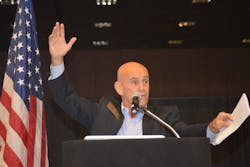Collision repair industry veteran describes technology-driven disruption, manages ADAS test drives with Copilot App
Technology is rapidly pushing the automotive industry to digitalization. Now and in the next few years, this disruption will impact everyone in the business, from OEMs to repair shops, and from CEOs to technicians, said Frank Terlep, CEO and co-founder of Auto Techcelerators LLC.
Terlep has been developing software for the automotive industry since the mid-’80s, with much of that for the collision repair segment. His recently published book, “Auto Industry Disruption,” discusses why technology is driving change and what stakeholders should expect in the near future. And at the Jan. 15 Collision Industry Conference, he introduced Test Drive CoPilot, a service-as-product smartphone application. It’s designed to document every dynamic calibration and/or test-drive to reduce liability, provide quality control, and provide documentation to make it easier to get paid for the procedure.
App helps shops manage ADAS test drives
A push to increase driving safety by reducing human operator error means more advanced driver assistance systems (ADAS) features, Terlep said. Only two years from now, he pointed out, 97 percent of all vehicles will be manufactured with at least one type of ADAS feature, automatic emergency braking (AEB.) At that point, he said, there will be close to 125 million AEB-equipped vehicles on the road. So, it’s important that these systems be calibrated, and the Test Drive CoPilot smartphone app can help shop managers quality-control dynamic calibrations and ensure test-drives are performed correctly. “I think it was a year to 18 months ago that one of the major consolidators in the United States surveyed 50 dealerships in a large MSA market to see if they were able to accurately perform calibrations, and out of 50, they identified five,” Terlep said. “A lot of shops think when they sublet the car to the dealer that the dealer knows what they’re doing, and a lot of times, they don’t. Test Drive CoPilot is for whether you did the calibration, a sublet vendor did it, or a dealer did it. In every one of those scenarios, you still need to do the test drive to make sure the systems operate as designed before you give the car to the customer. “Let’s use as an example the dynamic calibration of a blind spot monitor. I didn’t do any other calibration. So then the question becomes, ‘How do we know the other systems work, unless you test-drive?’ A dynamic calibration is really important, but it’s a piece of the validation process to make sure the systems operate, at least in my opinion.” Because some ADAS features are optional, the ideal time for repair facility personnel to identify how the vehicle is equipped is during the blueprinting process, Terlep said. “Because if they don’t, they really don’t know at that point A), how to repair it, and B), ‘Do I need a calibration, or not?’ I will tell you that my assumption is most businesses are not doing that today.”How it works
Test Drive CoPilot includes OEM-sourced checklists for a test-drive to ensure all functions work as designed. These can be printed out or displayed within the app (while the driver is stopped, of course.) During the test-drive, the smartphone is attached to a bracket that mounts with suction cups to the windshield or dashboard. While the app is open, the smartphone is dedicated to its test-drive function, and it cannot be used for anything else, such as calling or texting. The app records audio, video, speed, time, mileage, location, technician(s), insurer or fleet name, VIN, year, make, model, weather, and the cost of the test drive. For documentation purposes, Terlep recommends that the driver speak as each ADAS function is checked off the mental checklist, such as, “OK, I see the left blind spot monitor alerting me of a vehicle overtaking me, as it should.” The test drive report lists the details of what was recorded, including the start/stop time, high speed, low speed, and average speed, beginning and ending mileage. “And then we also produce a speed graph, which shows the vehicle speeds it went up and down over the period of the test drive, and we produce a detailed map of where that vehicle was driven, so they know it was actually driven. So that type of information is pretty detailed. There’s nothing else out there that gives that for the shop. In addition to that, we give the shop a billing statement, which is an actual amount of time spent. They can then produce that for reimbursement to a fleet, the insurance company, or the consumer.” The app’s recordings are maintained on the Auto Techcelerators servers as part of the monthly or annual subscription, and it includes up to 2TB of storage, or about 2,000 typical test-drives. Those can be used if a technician’s driving habits are ever called into question, or for certain “ever since you repaired” issues that should arise in which the consumer blames the collision repair for an unrelated fault.Disruption: ‘Data is the new oil’
Sophisticated vehicle sensors, networks,and internet connectivity will drive disruption for automotive industry stakeholders. For the first example, GM, along with connected services from makers such as Ford and Tesla, is now offering over-the-air (OTA) updates for vehicle software, instead of the customer visiting a dealer service department for programming. “The vehicle has a couple hundred sensors on it. Think about it: it’s got cameras, LIDAR, RADAR – those are all collecting data and then sharing it. So start to think of the data a vehicle can collect or is collecting, and then what can be done with that data down the road. To me, data is the new oil. I think the OEMs are being told by the McKinseys [management consulting company] of the world to look at data as being another revenue stream.” With an increasing number of onboard sensors, tomorrow’s vehicle will be able to communicate to the OEM its need for preventive maintenance or predict a needed repair. “And if you can do over-the-air updates from the manufacturer to the vehicle, where does the dealer play? I don’t think the manufacturer will eliminate the dealer, because that’s sort of their connection today to the consumer. Plus, the dealer buys the vehicle, and that’s how OEMs make their money. But it’s going to change the relationship, in my opinion.” This increased sophistication of onboard sensors and connectivity will also increase the accuracy of instant notice-of-loss transmissions, which will be an important development in assessing the likelihood of a vehicle being repaired. “I also think because of the data that is coming from the vehicle, the way vehicles are diagnosed for the electronics will be different than they are today. Within the next five years, using a scan tool to get DTCs from a vehicle will not be needed. Now, just because I have a DTC, it doesn’t mean I know what to do about it. But I think the cars themselves are going to generate them. At the same time, repair facilities are going to have to become much more adept with electronics. They’re not going to have a choice.”Remote photo estimates and video supplements are here to stay
“Whether you like it or not, remote photo-based estimating and remote video-based supplements are not going away,” Terlep said, because insurance companies will continue to find ways of reducing their loss-adjustment expense (LAE,) which is the expense associated with investigating and settling a claim. He looks for those methods to be implemented more. And artificial intelligence will soon play a large role in estimating. “Maybe not this year, but over the next five years. I’ve seen artificial intelligence estimating, and it is more accurate than the best estimator in the industry. Within five years, you’re going to see estimates being driven by imaging from artificial intelligence. It doesn’t get tired, it doesn’t get distracted, and it knows more data than the best estimator in the industry ever will.”About the Author
Jay Sicht
Editor-in-Chief, FenderBender and ABRN
Jay Sicht is editor-in-chief of FenderBender and ABRN. He has worked in the automotive aftermarket for more than 29 years, including in a number of sales and technical support roles in paint/parts distribution and service/repair. He has a bachelor's degree in journalism from the University of Central Missouri with a minor in aviation, and as a writer and editor, he has covered all segments of the automotive aftermarket for more than 20 of those years, including formerly serving as editor-in-chief of Motor Age and Aftermarket Business World. Connect with him on LinkedIn.
Don't miss Jay's next article or podcast. Sign up for FenderBender Today's Collision Repair News and ABRN eNews here.

